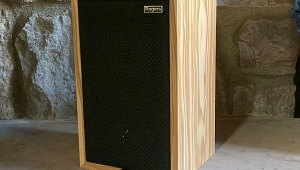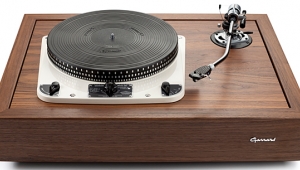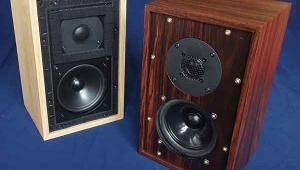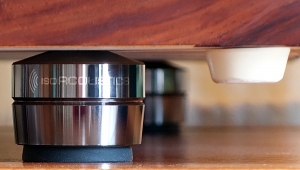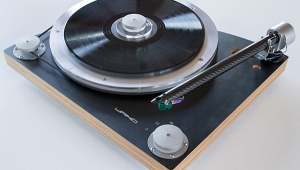| Columns Retired Columns & Blogs |
Listening #47
"Hail, mortal!"
—Michelle Pfeiffer as Titania, reacting to Kevin Kline as Bottom, when he succeeds in operating a phonograph
Footnote 1: Fellow reviewers who know of my fondness for writing long, turgid paeans to the most arcane technical aspects of phonograph design might rather escape my praise for their own reviews, but the simple fact remains: The most important step for anyone who wants to thoroughly understand the technology behind the Well Tempered Tonearm and Turntable is to read Peter Moncrieff's titanically long yet undeniably comprehensive article on those products in his enduring newsletter, the International Audio Review.
—Michelle Pfeiffer as Titania, reacting to Kevin Kline as Bottom, when he succeeds in operating a phonograph
Our shops are filled with clever answers. The trick is to find out which ones are attached to similarly intelligent questions.
Remember the Nakamichi "computing" turntable of the early 1980s? The biggest jewel in its engineering crown—the only jewel, some would say—was its ability to correct off-center records on the fly. The Nakamichi could determine, with astounding precision, how much correction a given record required, then compensate for the eccentricity by altering the platter's very center of rotation. It was impossible not to be impressed on some level.
It's safe to say that someone in the Nakamichi organization decided that off-center record pressings comprised the most serious obstacle to high-quality analog replay, and that that person was given a green light to chase down the solution, whatever the cost. The problem with such an approach is that a potentially huge engineering edifice is thus erected on a single, shaky spot.
I don't mean to pick on Nakamichi in particular, or on well-funded Japanese industrialists in general. Throughout my years as an audiophile I've been told, at various times and by various inventors, that the greatest problems in record playback were cartridge mistracking, excessive cartridge downforce, record warps, "unstable" turntable suspensions, turntable control buttons that require too much force, and the fact that records get dirty while they're being played. All of those problems and more were beaten into submission by engineering solutions that today look overwrought and silly, and should have looked overwrought and silly back then; all proved unworthy of being an engineering team's sole focus.
I was skeptical of some of those problems and their solutions from the start; others bamboozled me long enough for my powers of self-delusion to overwhelm the best of my five better senses. Still and all, I lived to tell the tale...and to buy a Linn LP12.
When I became a Linnie, I did so partly because the stage had been expertly set for such a transformation. After years of abject foolishness, here was a product with two overarching strengths: The LP12 and its various companion tonearms and cartridges comprised a holistic system, in which every part worked together, and the guiding principle behind that design was simply that the thing should play melodies and rhythms better and more convincingly than any other thing.
The downside of being taken in by such a product—reasonably and rightly taken in, I mean—is that it tended to blind me to other, equally valid approaches. So when a retired aerospace engineer named Bill Firebaugh introduced the Well Tempered Tonearm some 21 years ago, then followed it up with the Well Tempered Turntable, I looked, but I did not see—if you see what I mean.
Luckily, not everyone else was so pig-sighted (footnote 1). Firebaugh's products met with enough success that they continue to attract a following even in these dark days—when, as the woodies tell us, analog is dead, mono is obsolete, and Western Electric doesn't make tubes anymore.
Temper, temper
The English language is full of words of more than one meaning, including words whose different meanings contradict one another—but no other verb is quite so glaring in that regard as temper, which means either to harden or to soften. Take your pick.

Let's pick the latter: To temper the tuning of a musical instrument is to soften it, to distort it, to make it less woody and more fuzzy. Because the frequencies associated with musical notes of steadily increasing pitch describe a geometric progression—what we hear as the next note up is actually more than the next step up in terms of frequency—then the tuning of any musical instrument must be fuzzied up a bit if it is to play in more than one key. A piano that's tuned in such a way that a major third sounds perfect in the key of C can't possibly exhibit a similarly right-sounding major third in any other key. Thus the things that are perfect must be made a little less perfect so that the things that are awful can be made a little less awful. (Educators know this as grading on the curve: You're all special!)
I don't know for sure why Bill Firebaugh evoked that concept in naming his company Well Tempered Lab, but I imagine it had something to do with the manner in which his designs were a reaction to those of his predecessors. In particular, the Linn (and Linn-inspired) record players from 1973 forward toed a noble theoretical line, stressing the need for rigid, playless bearings for platters and tonearms alike. Firebaugh had a different point of view: No matter how well made, no matter how expertly pre-loaded, all metal-to-metal bearings require some amount of play in order to work at all, and thus all metal-to-metal bearings exhibit intolerable levels of high-frequency chatter.
Firebaugh's response was twofold. His first product, the Well Tempered Tonearm, dispensed with traditional vertical and horizontal bearings in favor of what the designer described as a convergent skewed bifilar ligament suspension. Loosely translated from the Patentese, that means that the tonearm tube hangs from a beam using two strands of fishing line, whose paths intersect at some point in space between hanger and hangee.
You might think such a thing couldn't work. You might think that the absence of a rigid, captured bearing would result in a loss of information. But Newton's laws of reciprocal action suggest otherwise—which is why phonography works in the first place, and why high-frequency, low-amplitude groove modulations don't merely wiggle the comparatively massive armtube-and-cartridge-body combination this way and that. And while the mass of an armtube of reasonable size isn't enough to keep it from being moved to the point of perturbation—as in its vertical plane, in response to inevitable record warps and variations in thickness—a judicious amount of physical damping can save the day.
That's something Firebaugh executed with particular cunning: The tube of his Well Tempered Tonearm is rigidly fastened to a flat disc roughly the size and shape of a poker chip. That paddle, which is the part of the arm that actually hangs from the nylon strands, spends all of its time relaxing in a metal cup filled with a viscous silicone fluid more or less the consistency of honey. No doubt you can imagine the consequence: The fluid presents little resistance as the relatively thin paddle rotates in the lateral plane, allowing the armtube to trace the record groove. But the resistance of the goo, and thus its damping effect, is significantly greater in the vertical plane.
In all, the WT Tonearm is as different from a Linn Ekos or Naim Aro arm as a Citroën is from a Subaru, even though in each pairing the two things accomplish more or less the same task. Both approaches account for the fact that the resonant energy created during record playback is itself a cause of distortion, while the Linn and others like it tackle the problem by making sure that every part of the player as a whole can resonate in response to that energy in precisely the same manner, thus preventing the distorting effects of allowing different parts of the record-playing system to move relative to one another. But the WT Tonearm tackles the problem by attempting to eliminate the unwanted energy before it has a chance to sully the works, by means of damping.
Footnote 1: Fellow reviewers who know of my fondness for writing long, turgid paeans to the most arcane technical aspects of phonograph design might rather escape my praise for their own reviews, but the simple fact remains: The most important step for anyone who wants to thoroughly understand the technology behind the Well Tempered Tonearm and Turntable is to read Peter Moncrieff's titanically long yet undeniably comprehensive article on those products in his enduring newsletter, the International Audio Review.
- Log in or register to post comments


